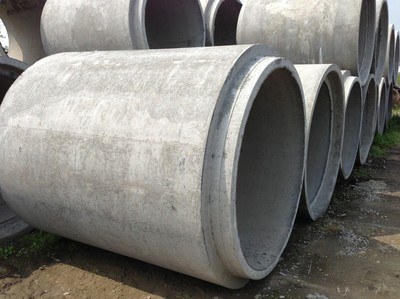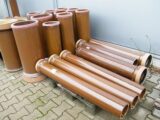Regular and reinforced concrete pipes

These pipes are produced in Egypt, using sulfate-resistant cement, and they are produced with flexible connectors, working in slope lines for sewage water, as well as drinking water lines, and they are made using the pressure or extrusion method, and pipes with a diameter of less than 5 inches are difficult to arm.
Concrete required for piping contains 1 part cement, 1.75 parts clean sand, and 2.5 parts clean slag sand, measuring 0.5 “for pipes 20” and less, and 0.75 “for pipes over 20”.
Among its most important features:
1- It is produced up to a diameter of 300 mm and in reinforced concrete the diameters reach 3000 mm.
2- Flexible connections – which gives it a great advantage – when a soil subsidence occurs, the pipeline rearranges its positions without any breakage or crack in the pipe.
3- Less expensive than metal pipes.
4- It can be produced locally.
5- The cement weld adheres to it more than clay pipes.
Disadvantages of concrete pipes:
1- Does not bear the interaction of sewage gases and is afraid of corrosion if it is not full (sewage water).
2- Heavier than clay, cast or steel pipes.
3- The lack of quality in their manufacture in small factories.
4- It needs care in its manufacture in order to be able to conform to the standard specifications.
5- It is not easy to find out the faults of a concrete pipe without special tests.





Thanks for the good article, I hope you continue to work as well.Спаситель на продажу
Hottest Videos 2021! Click Here: http://bit.do/fSL4K ❤️
❤️ Natalie want to meet you! Click Here: http://bit.do/fSNfb ❤️
❤️ Emily want to meet you! Click Here: http://bit.do/fSRzN ❤️
קמגרה תשדרג לכם את חיי המין ותאפשר לכם הנאה מרבית מהאקט. לטבע פלז’ר שלל פתרונות טבעיים נוספים שישדרגו לכם את חדר המיטות. קמגרה תשדרג לכם את חיי המין ותאפשר לכם הנאה מרבית מהאקט. לטבע פלז’ר שלל פתרונות טבעיים נוספים שישדרגו לכם את חדר המיטות. שרות ליווי
קמגרה למכירה בהרצליה אנשים באים אליה מהצפון, מהמרכז ומהדרום. לא לחינם נחשבת הרצליה לאחת מהערים המובילות בישראל בתחום הפנאי והבילויים. הרצליה היא עיר תוססת, עם מפגשים אנושיים רבים, metamask token factory example
❤️ Paula want to meet you! Click Here: http://inx.lv/p0Df ❤️
❤️ June want to meet you! Click Here: http://inx.lv/p0Df ❤️
כחלק מהשירות, אנו מעניקים משלוחים בכל הארץ עד לבית הלקוח ושומרים עבורך על דיסקרטיות מלאה. Jessica want to meet you! Click Here:
כל הכתוב באתר הינו מידע כללי בלבד. הכתוב באתר אינו מהווה יעוץ רפואי או המלצה לרכישה או שימוש בטיפול או מוצר כל שהוא המופיע באתר. נערות ליווי בהוד השרון
קמגרה למכירה בחולון חולון היא אחת הערים הגדולות ביותר במדינת ישראל (קצת מפתיע שלא הרבה אנשים יודעים את זה). לא מעט זוגות מעדיפים לבסס את מקום מושבם ומשפחתם נערות ליווי בכפר סבא
a Maria – Dance, Maria [Official Music Video]
Teen want to meet you! Click Here: http://inx.lv/jutg
ビットコインカジノボーナス2022
BOOKING CHEAP AIRLINE TICKETS FROM LOUISIANA TO CAPE VERDE
BOOKING CHEAP AIRLINE TICKETS FROM SOUTH CAROLINA TO OREGON
BOOKING CHEAP AIRLINE TICKETS FROM FORT SMITH AIRPORT TO SWAZILAND
BOOKING CHEAP AIRLINE TICKETS FROM CHICAGO OHARE INTERNATIONAL AIRPORT TO UNITED KINGDOM
BOOKING CHEAP AIRLINE TICKETS FROM LAKE HOOD AIRPORT TO ALGERIA
BOOKING CHEAP AIRLINE TICKETS FROM ALTOONA-BLAIR COUNTY AIRPORT TO PORTUGAL
BOOKING CHEAP AIRLINE TICKETS FROM COLORADO TO ISRAEL
BOOKING CHEAP AIRLINE TICKETS FROM GREENBRIER VALLEY AIRPORT TO PAPUA NEW GUINEA
BOOKING CHEAP AIRLINE TICKETS FROM GREATER ROCHESTER INTERNATIONAL AIRPORT TO ITALY
BOOKING CHEAP AIRLINE TICKETS FROM MIAMI INTERNATIONAL AIRPORT TO PENNSYLVANIA
BOOKING CHEAP AIRLINE TICKETS FROM KING COVE AIRPORT TO LOUISIANA
BOOKING CHEAP AIRLINE TICKETS FROM LOS ANGELES TO OH
BOOKING CHEAP AIRLINE TICKETS FROM GUSTAVUS AIRPORT TO SRI LANKA
BOOKING CHEAP AIRLINE TICKETS FROM GALBRAITH LAKE AIRPORT TO KY
BOOKING CHEAP AIRLINE TICKETS FROM MINNEAPOLIS TO ZAMBIA
BOOKING CHEAP AIRLINE TICKETS FROM SLOULIN FIELD INTERNATIONAL AIRPORT TO NM